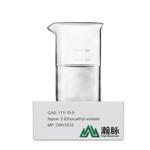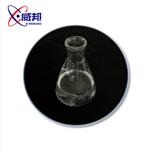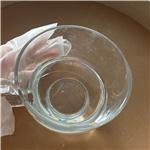Description
Ethylene glycol monoethyl ether acetate (also known as 2-Ethoxyethyl Acetate) belongs to the family of glycol ethers that are commonly used in paints and cleaners, e. g. for cellulose nitrate paints. Its properties can also be exploited in coatings for brushing on, dip coating and spraying, and for stove enamels. 2-Ethoxyethyl acetate is also used as a liquid pesticide product1. It is used as a solvent dissolve resin, leather, ink, for the formulation of paints, lacquers and varnishes for industrial use. It is also used to study the field evaluation of a passive badge for measuring the level of 2-ethoxyethyl acetate. It is also used to study the field evaluation of a passive badge. Another application for 2-Ethylhexyl Acetate is as an additive in cleaners and paint removers.
Description
2-Ethoxyethyl acetate is a colorless liquid witha mild, nonresidual odor. The odor threshold is 0.056 ppmin air. Molecular weight = 132.18; Specific gravity(H2O:1) = 0.98 at 20℃; Boiling point = 156℃; Freezing/Melting point = - 61.7℃; Vapor pressure = 2 mmHg at20℃; Flash point = 47℃; Autoignitiontemperature = 380℃. Explosive limits: LEL = 1.7%;UEL = 12.7%. The UEL is also reported as 14%. HazardIdentification (based on NFPA-704 M Rating System):Health 2, Flammability 2, Reactivity 0. Soluble in water;solubility = 23%
Chemical Properties
2-Ethoxyethyl acetate is a colorless liquid
with a mild, nonresidual odor. The Odor Threshold is
0.056 ppm in air
Chemical Properties
colourless liquid
Physical properties
Colorless liquid with a faint, pleasant odor. Experimentally determined detection and recognition
odor threshold concentrations were 300 μg/m
3 (60 ppb
v) and 700 μg/m
3 (130 ppb
v), respectively
(Hellman and Small, 1974). Nagata and Takeuchi (1990) reported an odor threshold concentration
of 49 ppb
v.
Uses
2-Ethoxyethyl acetate is used as a solvent dissolve resin, leather, ink, for the formulation of paints, lacquers and varnishes for industrial use. It is also used to study the field evaluation of a passive badge for measuring 2-ethoxyethyl acetate.
Uses
In the coatings industry, especially in
the semiconductor industry; solvent for nitrocellulose
and some resins
Uses
Solvent for nitrocellulose, oils, and resins;
retards “blushing” in lacquers, varnish removers,
wood stains, textiles, and leather.
General Description
A clear colorless liquid with a pleasant odor. Flash point of 120°F. Less dense than water. Vapors are heavier than air.
Air & Water Reactions
Flammable. Slightly soluble in water.
Reactivity Profile
Mixing Ethylene glycol monoethyl ether acetate in equal molar portions with any of the following substances in a closed container caused the temperature and pressure to increase: chlorosulfonic acid, oleum, and vinyl acetate, NFPA 1991.
Hazard
Toxic by ingestion and skin absorption.
Toxic by skin absorption.
Health Hazard
Vapors irritate nose and eyes in high concentrations. Liquid irritates skin in prolonged or repeated contact.
Fire Hazard
HIGHLY FLAMMABLE: Will be easily ignited by heat, sparks or flames. Vapors may form explosive mixtures with air. Vapors may travel to source of ignition and flash back. Most vapors are heavier than air. They will spread along ground and collect in low or confined areas (sewers, basements, tanks). Vapor explosion hazard indoors, outdoors or in sewers. Runoff to sewer may create fire or explosion hazard. Containers may explode when heated. Many liquids are lighter than water.
Safety Profile
Moderately toxic by
ingestion and intraperitoneal routes. A skin
and eye irritant. An experimental teratogen.
Other experimental reproductive effects.
Flammable liquid when exposed to heat or
flame; can react with oxidizing materials.
Moderate explosion hazard in the form of
vapor when heated. Mild explosions have
occurred at the end of disullations. To fight
fire, use alcohol foam, CO2, dry chemical.
When heated to decomposition it emits acrid smoke and irritating fumes. See also
GLYCOL ETHERS.
Potential Exposure
This material is used as a solvent for
many different purposes; including for nitrocellulose and
other resins. Used in automobile lacquers to retard evaporation and impart a high gloss.
First aid
If this chemical gets into the eyes, remove anycontact lenses at once and irrigate immediately for at least15 min, occasionally lifting upper and lower lids. Seek medical attention immediately. If this chemical contacts theskin, remove contaminated clothing and wash immediatelywith soap and water. Seek medical attention immediately. Ifthis chemical has been inhaled, remove from exposure,begin rescue breathing (using universal precautions, including resuscitation mask) if breathing has stopped and CPR ifheart action has stopped. Transfer promptly to a medicalfacility. When this chemical has been swallowed, get medical attention. Give large quantities of water and inducevomiting. Do not make an unconscious person vomit.
Environmental Fate
Biological. Bridié et al. (1979) reported BOD and COD values of 0.74 and 1.76 g/g using
filtered effluent from a biological sanitary waste treatment plant. These values were determined
using a standard dilution method at 20 °C for a period of 5 d. The ThOD for 2-ethoxyethyl acetate
is 1.82 g/g.
Chemical/Physical. At an influent concentration of 1,000 mg/L, treatment with GAC resulted
in an effluent concentration of 342 mg/L. The adsorbability of the carbon used was 132 mg/g
carbon (Guisti et al., 1974).
storage
Color Code—Red: Flammability Hazard: Store ina flammable liquid storage area or approved cabinet awayfrom ignition sources and corrosive and reactive materials.Prior to working with this chemical you should be trainedon its proper handling and storage. Before entering confinedspace where this chemical may be present, check to makesure that an explosive concentration does not exist. 2-Ethoxyethyl acetate must be stored to avoid contact withstrong oxidizers, such as nitrates, permanganates, bromine,chlorine, and chlorine dioxide; strong alkalis, such assodium hydroxide and potassium hydroxide; and strongacids, such as nitric, hydrochloric, and sulfuric acids, sinceviolent reactions occur. Store in tightly closed containers ina cool, well-ventilated area away from heat. Sources ofignition, such as smoking and open flames, are prohibitedwhere 2-ethoxyethyl acetate is used, handled, or stored in amanner that could create a potential fire or explosionhazard.
Shipping
UN1172 Ethylene glycol monoethyl ether acetate, Hazard Class: 3; Labels: 3-Flammable liquid
Purification Methods
Shake the ethoxy-ethane with anhydrous Na2CO3, filter and distil it in a vacuum. Redistillation can then be carried out at atmospheric pressure. [Dunbar & Bolstad J Org Chem 21 1041 1956, Beilstein 2 IV 214.]
Incompatibilities
May form explosive mixture with air.
Incompatible with strong acids; strong alkalies; nitrates.
Violent reaction with oxidizers. May form unstable peroxides.
Softens many plastics. Attacks some plastics, rubber, and
coatings
Toxics Screening Level
The initial threshold screening level (ITSL) for ethylene glycol monoethyl ether acetate (EGEEA) is 290 μg/m3 based on a 24-hour averaging time.
Waste Disposal
Dissolve or mix the material
with a combustible solvent and burn in a chemical incinerator equipped with an afterburner and scrubber. All federal,
state, and local environmental regulations must be observed.








